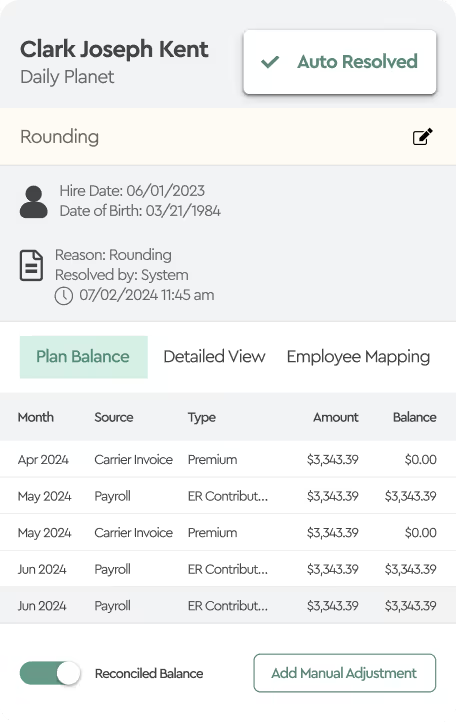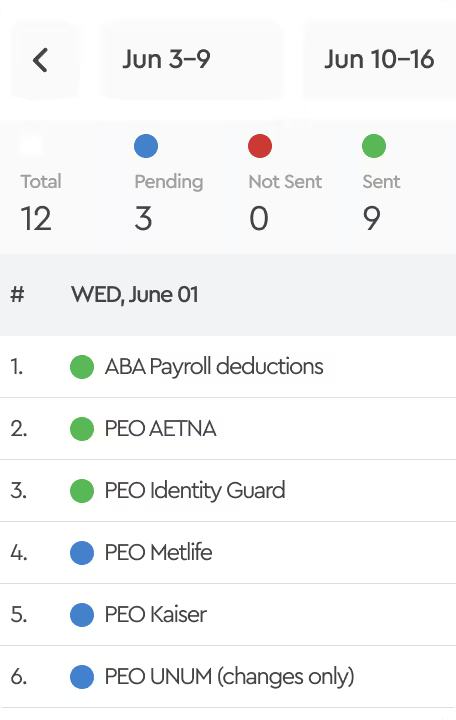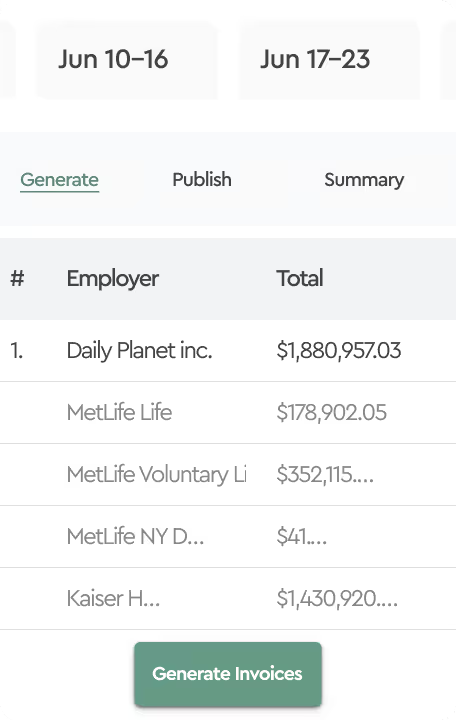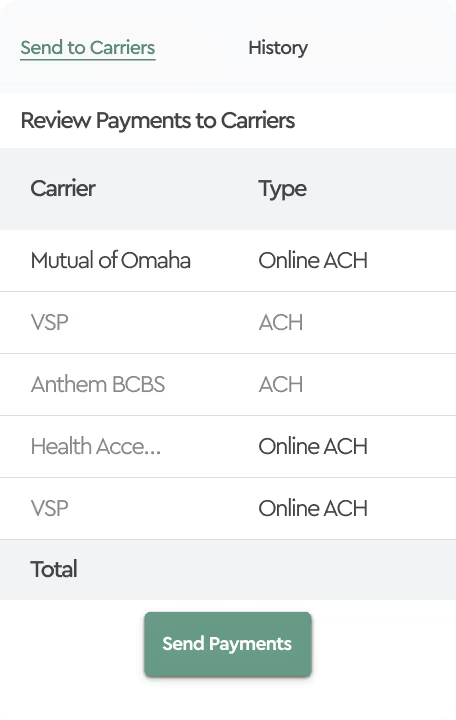March 16, 2022
How we saved our clients $531,742 in one year
Employee benefits are an essential component of attracting and retaining top talent in today's competitive job market. However, many employers may not be aware that they are losing significant amounts of money due to errors and inefficiencies in benefits billing. We took an in-depth look at the data from our own clients, analyzing write-offs over a two-year period, and discovered surprising revelations about where employers are losing benefits dollars. This blog post will explore the causes, the numbers, and how implementing consolidated invoicing and benefits reconciliation can help your organization save valuable resources.
Key Point #1:
The Perils of Multiple Systems with Manual Configuration
Many employers utilize separate enrollment and payroll systems, alongside manual data entry processes for COBRA and emergency enrollments. These disparate systems can create a perfect storm of confusion and inefficiency, leading to costly errors.One of the main issues is that these systems are often maintained by different teams. Each team might have varying levels of expertise, experience, and commitment to maintaining the quality of the system. This inconsistency can lead to data discrepancies, making it difficult to reconcile even one set of systems, let alone multiple sets.Furthermore, these systems don't only differ in how they handle employee names and identifying information. They can also have different names and descriptions for the same plans and benefits, causing even more confusion when trying to match records across systems.
In this illustration, we demonstrate the discrepancies that can arise when the same employee and plan are represented in three different systems:

Enrollment system
First name: Ken
Middle name: P.
Last name: Lee
SSN: 1234********
Plan Name: OAMC 500
Plan Description:
ER Funded Short-Term Disability-Employee Only
Payroll system
Employee Name: Kenneth Peter Lee
SSN: (NOT AVAILABLE)
Plan Name: AETNA-OAMC-500/80-NB
Plan Description: STD
Deduction amount: $80.74
Pay Frequency: Bi-Weekly
Carrier Invoice
Employee name: Lee, Ken P.
Plan Description: STD Cigna
Tier: EMP+Family
Rate: $161.48
This example highlights the inconsistencies between different systems in terms of naming conventions, plan descriptions, employee names, and the availability of key data like Social Security Numbers. These discrepancies can make benefit plan reconciliation challenging, emphasizing the need for effective tools and processes to improve accuracy and efficiency.
Key Point #2: The Responsibility Conundrum

Determining who should be responsible for preventing benefits billing errors is a challenge. In many instances, reconciliation is ignored by both the benefits and accounting teams. This lack of accountability can lead to costly mistakes and lost benefits dollars.
Benefits teams often find themselves understaffed and overworked, trying to manage complex benefits processes with limited resources. They usually rely on Excel spreadsheets, which, while useful, have their limitations when it comes to handling complex benefits processes. As a result, it's difficult for benefits teams to come up with a formula that can match records across disparate systems, leading to errors and inefficiencies.
Accounting teams, on the other hand, may not have the specialized knowledge required to handle complex benefits processes. They may also lack access to HR systems, which can result in errors and inefficiencies when it comes to benefits billing and reconciliation.
The Numbers: A Closer Look at Lost Benefits Dollars
Our analysis revealed an average of $6.47 per employee per month in premium write-offs during the first quarter. This may not seem significant initially, but multiplying it by the number of employees demonstrates the true impact:
One quarter: $6.47 x 21,182 = $136,944
Pre-Tabulera numbers:
Total Benefit Write-Offs: $136,944
Benefit Premium Write-off: 0.79%
Benefit Premium Processed: $17.4 million
Employees per Quarter: 21,182
These numbers reveal the hidden costs of inefficient benefits billing process. Over time, these costs can add up and significantly impact an organization's bottom line.
Addressing the Problem: Implementing Consolidated Invoicing and Benefits Reconciliation
To combat these issues, we introduced two modules for our clients: Consolidated Invoicing and Benefits Reconciliation. These modules were designed to streamline the benefits billing process and reduce the likelihood of errors and inefficiencies.
The Consolidated Invoicing module combines carrier list bills and generated self-bills into a single monthly invoice. This simplifies the invoicing process and frees up Accounts Payable staff from having to manage and pay multiple invoices each month. By consolidating invoices, the module also makes it easier for accounting teams to track benefits spending and ensure that payments are made on time.
The Benefits Reconciliation module filters out timing differences and identifies potential system misconfigurations. This allows the Benefits team to focus on employees who require attention and helps prevent billing errors. The module automates much of the reconciliation process, flagging issues such as:
- Employee terminations that are still being invoiced
- Deductions from employees who aren't present on an invoice
- Rate differences between payroll, enrollment, COBRA, and carrier invoices
By automatically categorizing these variances and calculating self-bills, the Benefits Reconciliation module enables HR teams to address discrepancies more efficiently.

The Impact: Substantial Time and Cost Savings
By the third quarter, most clients had reduced their premium write-offs to about $0.22 per employee per month, a 97% reduction. This demonstrates the powerful impact of implementing consolidated invoicing and benefits reconciliation on an organization's bottom line.
Despite some residual write-offs due to varying implementation timelines and delayed reporting of terminations, the overall impact was significant. The case study covered multiple employers that were not implemented at the same time, which may have contributed to some of the remaining write-offs.
Benefits reconciliation can introduce substantial time and cost savings by allowing HR teams to focus on analyzing variances instead of manually checking every employee's information. This can reduce the labor-intensive aspect of the process by up to 90%, freeing up HR professionals to focus on other important tasks.
Let's take a closer look at the complete timeline. By analyzing the data over two years, we were able to track the progress of our clients' benefits billing processes. In the beginning, premium write-offs were a significant issue, causing unnecessary financial strain on the organizations. However, as the clients implemented the Consolidated Invoicing and Benefits Reconciliation modules, the write-offs began to decrease dramatically.
By Q3, most clients had normalized their Write-Offs of premiums to about $0.22 PEPM, effectively eliminating the issue for many employers. This demonstrates the power of implementing efficient benefits billing processes and tools, which can help organizations save valuable resources and improve their bottom lines.

Conclusion
Inefficiencies in benefits reconciliation can lead to lost dollars for employers, negatively impacting their financial health. By addressing the challenges posed by disparate systems, manual processes, and lack of accountability, organizations can save valuable resources and ensure accurate benefits billing.
Implementing Consolidated Invoicing and Benefits Reconciliation can have a significant impact on an organization's bottom line, reducing premium write-offs by up to 97%. With the potential for substantial time and cost savings, these tools should be considered by any organization looking to streamline their benefits reconciliation process and eliminate unnecessary expenses.
If you know someone who is tired of wrestling with spreadsheets and dealing with the headaches of inefficient benefits reconciliation, please share and repost this analysis to spread awareness about the potential benefits of implementing consolidated invoicing and benefits reconciliation. By shedding light on the hidden costs of employee benefits reconciliation and sharing solutions to address these challenges, we can help organizations save money and better support their employees.











